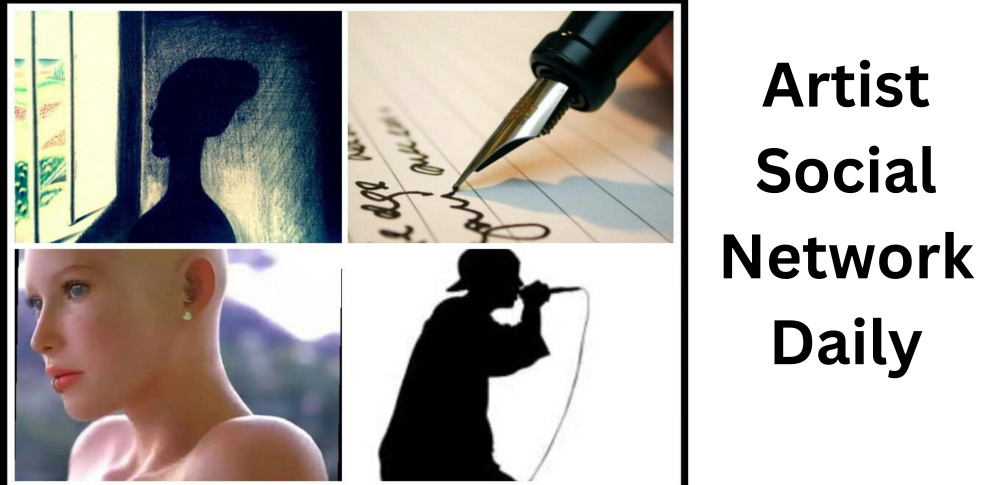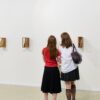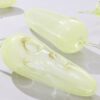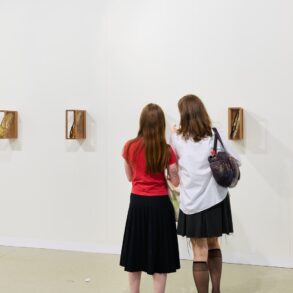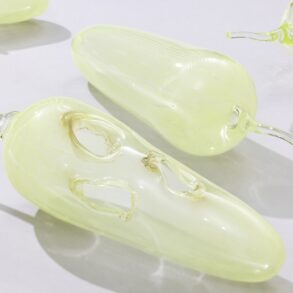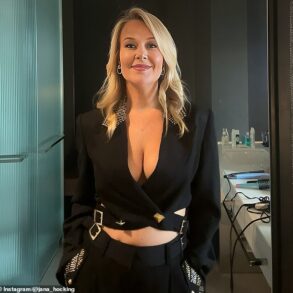The escalator carries me down to Level 2 of the Art Gallery of New South Wales, where I’m set to interview Melbourne-based, Pakistan-born artist Nusra Latif Qureshi, whose first major solo exhibition is on display here.
Birds in Far Pavilions spans three decades of work — from Qureshi’s early work when she was training as a painter in Lahore, to her newest installation, Museum of Lost Memories (2024).
I peek into the exhibition while waiting for Qureshi and I’m drawn to a small painting, Sacred Boundaries (1995). At first, I miss it: the figure of a woman fleeing at the frame’s edge. Once I see her, I’m struck by how this partial concealment creates tension, a familiar push-and-pull between revealing and concealing.
I sense I’m about to meet someone who understands the instinct to hide.
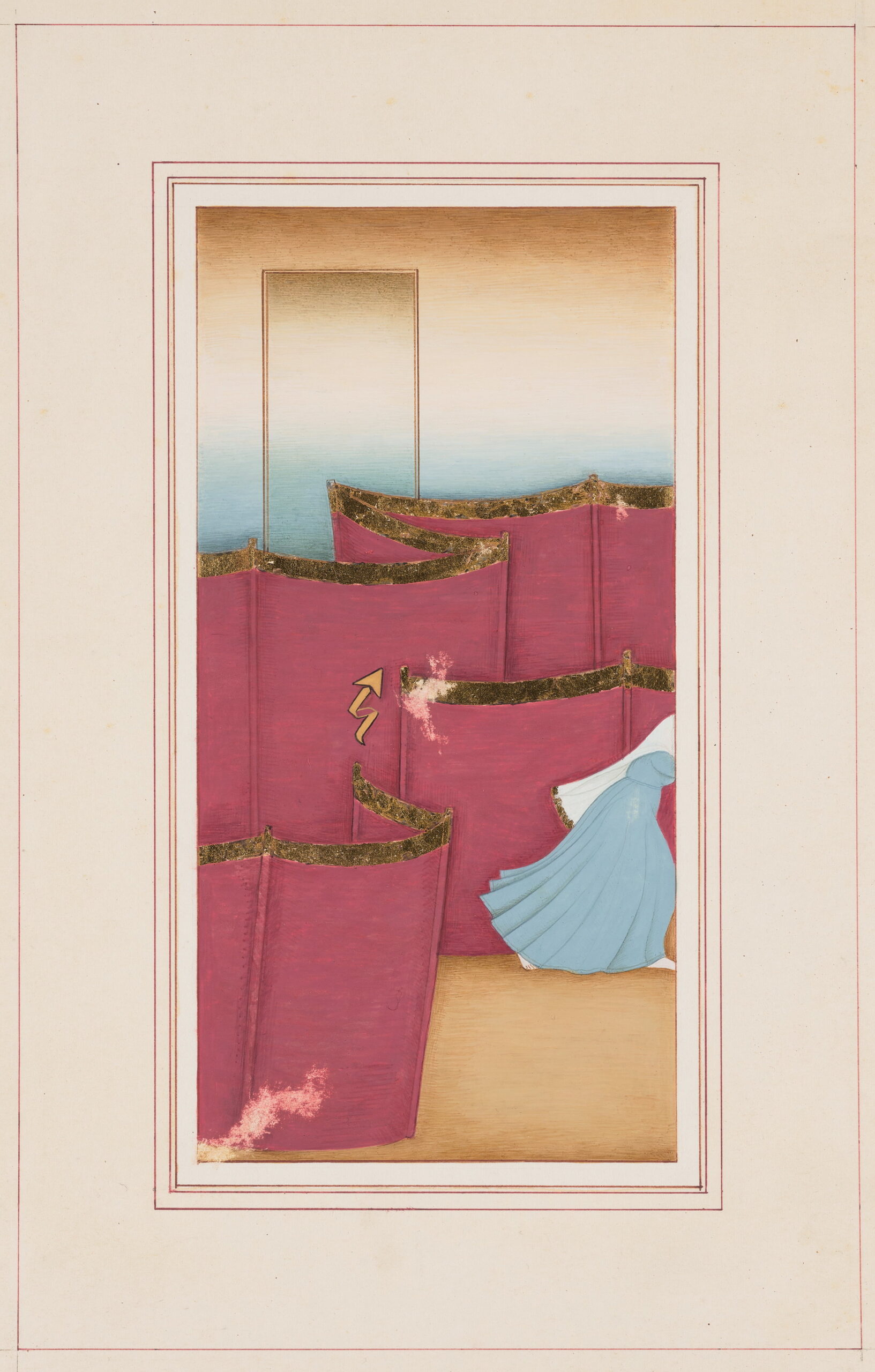
In Sacred Boundaries, Qureshi’s 1995 work, the fleeing figure amplifies tension beyond the frame. (Image: Nusra Latif Qureshi. Photo: Art Gallery of New South Wales, Felicity Jenkins.)
When Qureshi arrives, I recognise her immediately. She resembles the doubled figure in a painting of hers I’ve just finished studying, Besides Me (1997).
Qureshi has a warm and composed presence — confident yet unembellished — like the women in her paintings who carry a quiet assurance.
Nervous — I’m an artist, not a journalist — I begin our interview by asking a standard question about the exhibition’s chronology. She smiles, her voice calm: “We didn’t focus on chronology. Instead, we wanted a loose thematic flow. Matt [Cox, the curator] and I looked at how images repeat, how themes simmer beneath the surface.”
I ask about the fleeing woman in Sacred Boundaries, and Qureshi tells me this figure anchors the exhibition’s energy. I wonder if the women in her paintings represent her.
“They’re not autobiographical,” she says. “They fight my battles, but they’re not me.”
Qureshi’s female figures challenge conventions. She rejects static portrayals of women as symbols of beauty or divinity.
Her fragmented figures and recurring motifs — hands, fabric, pistols, birds, threads — oscillate between presence and absence. They draw viewers in, asking them to complete the narrative.
“Women have always been symbols in an art-historical sense — but never themselves,” she says.
“I want to reclaim that space on their terms, not as objects of someone else’s gaze.”
‘She’s moving. She has agency’
At first glance, Qureshi’s compositions feel serene — red partitions, blue skies — but the more I look, the less contained they seem.
The figures in her work represent a woman who “is not static or passive”, Qureshi says.
“She’s moving. She has agency. That was important to me — she’s not trapped.”
Calling Qureshi’s work, including this 1997 painting Besides Me, “miniature” risks diminishing it.
(Image: Nusra Latif Qureshi. Photo: Art Gallery of New South Wales)
This sense of movement extends to the conceptual frames of her art.
Historically, frames were meant to illuminate and embellish, as seen in the 16th-century Mughal paintings displayed alongside her work.
Qureshi threads these past traditions through her own pieces, then playfully disrupts them. “I wanted to see what happens when you push beyond those boundaries,” she says. “Can you challenge the frame while still respecting tradition?”
Qureshi studied at the National College of Arts in Lahore, where she studied painting in a Bachelor of Fine Arts. She moved to Australia in 2001 to pursue postgraduate studies, completing a Master of Fine Arts at the Victorian College of the Arts (VCA) in Melbourne, where she has lived and worked ever since.
The exhibition wall text notes her training in the traditional art of Mughal miniature (musaviri) painting. I ask Qureshi about the meaning of musaviri and she explains that it simply means “painting”.
Qureshi’s female figures shouldn’t be mistaken for passive; rather they are expanding notions of the feminine and of beauty. (Image: Nusra Latif Qureshi)
Her art is often described in the Western art world as “miniature painting” — but she rejects that term as a colonial label.
“‘Miniature’ was imposed by colonial art historians,” she explains. “It shrinks a vast practice into something quaint. Musaviri is not miniature — it’s expansive.”
Letting go of control
We step into a section devoted to her student work, though “student” feels absurd. The precision, conceptual layering, and political undertones already hint at a mature voice.
From 1994 to 1995, Qureshi delved into the tradition of manuscript painting and the storytelling practices of late-19th century Urdu. The exhibition’s five student paintings reflect Pakistan’s political history from 1947 to 1995.
“I divided it into five decades,” she explains. “The first focused on the founder of the nation. The second on the first martial law, the first military dictator, and the influence of American aid. Then came Zulfikar Ali Bhutto — his rise and deposition. The fourth covered the second military dictator’s long regime, and the fifth saw Benazir Bhutto’s emergence and shifting political tides.”
Her rigorous intellectual approach meets masterful painterly technique, each informing the other. The result is a dynamic interplay between beauty and critique.
Refined Portraits of Desire (2018) features in Birds in Far Pavilions, Qureshi’s first major solo exhibition. (Photo: Art Gallery of New South Wales, Felicity Jenkins)
Later paintings, like Drippings (1996–1999) and Departing Clouds (1999), pushed further.
“At that stage, I was playing with spontaneity and deliberation. Our training was exact — plan every stroke. But I wanted to see what happened if I let go of control.
“Why are historical paintings so beautiful? What if I abandoned beauty entirely?”
The resulting drips, fragmented forms and the unfinished edges invite viewers to question assumptions about aesthetics and tradition.
“I was testing extremes: meticulous planning versus total surrender,” Qureshi says.
As we move into the gallery’s larger space, the scope of her commentary broadens. Works like Boat People (2007) and Where the Sun Never Sets (2008) highlight national paradoxes.
“They’re about the Tampa,” she explains. “There is pride in European maritime history but fear of other ‘boat people.’ On one side, we celebrate lifesavers. On the other, we criminalise those seeking safety. It’s a selective narrative.”
Boat People (2007) explores the aftermath of 2011’s “Tampa affair”, which prompted the offshore detention of asylum seekers. (Image: Nusra Latif Qureshi)
She clarifies that this isn’t a critique of lifesavers, but of societal and political double standards: “We save some lives and abandon others.”
‘Not interested in exoticising myself’
Walking through Birds in Far Pavilions feels like entering a conversation mid-sentence. Stories hang in the air, waiting to be pieced together. A woman flees a frame, a delicate hand emerges with needle-thin precision, and the viewer hovers in uncertainty.
The conversation is also about Qureshi herself.
To interact with the works in Birds in Far Pavilions is to be in dialogue with Qureshi herself. (Photo: Art Gallery of New South Wales, Jenni Carter)
She acknowledges her layered identity but refuses to be pigeonholed. “I’m not interested in exoticising myself,” she says.
“I was born in Pakistan, but I’ve worked predominantly in Australia. My heritage informs my work, but it doesn’t define it entirely.”
Qureshi’s practice defies tidy categorisation. She honours traditions — Mughal painting, manuscript illumination, floral Urdu storytelling — while reshaping them.
Frames are expanded, narratives are unsettled and her female subjects resist containment.
The works invite viewers to consider what lies beyond the edge of the frame, what histories endure beneath gilded surfaces, and how meaning emerges when we step out of comfortable boundaries.
Qureshi’s art, much like the fleeing figure in Sacred Boundaries, keeps moving — beyond frames, beyond borders and beyond expectations.
Birds in Far Pavilions runs until June 15, 2025 at the Art Gallery of New South Wales.
This post was originally published on this site be sure to check out more of their content
